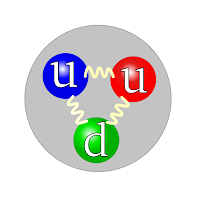The currently widely held wisdom is that quarks, the subatomic constituents that make up protons and neutrons, cannot be found in an unbound state, (i.e. roaming freely outside of a proton, neutron, or other particle made up of quarks). The reasoning goes that the attractive force due to the strong force between two quarks is so powerful that if they are separated far enough apart, there will be enough energy stored in the strong field to create two additional quarks that will immediately glom on to the two you were trying to separate in the first place, hence, no independent unbound quarks.
4. New York Times Obituary for William Fairbank
In 1977, however, Larue, Fairbank[1], and Hebard reported that they had found evidence indicating that free quarks did in fact exist[2]. Their experiment involved suspending a 1/4 mm superconducting niobium sphere in a magnetic field gradient[7] and causing it to oscillate in a vertical direction. The researchers measured the effects reversing the polarity of an applied electric field had on the sphere's oscillation frequency. Using this data, they were able to calculate how much free charge was present on the sphere. They wound up with the charge data shown below [3] (picture 2)
The scientific community at large, at least those who remember the work at all, tend to remember the penultimate incident in the history of the experiment. Luis Alvarez suggested that to remove any possibility that humans had tainted the data by performing subjective data cuts, random numbers should be added to a newly taken data set. That data was to be 'blind' analyzed and the results were to be reported. What most people will tell you is that the published results after this analysis were less than conclusive. What they'll leave out or don't know is that the published blind results contained a number of disclaimers that the graduate students in charge of the project had setup the apparatus incorrectly and that most of the inconclusiveness could just as easily be attributed to this poor setup.
In 1989 after two years of retirement, William Fairbanks returned to Stanford to perform more work on the fractional charge experiment. Sadly, he died soon thereafter on a morning jog after spending the night before working on the fractional charge experiment. In an obituary befitting the X-Files the New York Times reported
"Although Dr. Fairbank retired two years ago as physics professor at Stanford University, he had been at work there the night before his death, trying to verify his report of 11 years ago concerning the existence of individual subatomic particles called quarks."[4]
While there are claims that the experiment was reproduced by other researchers, there are interesting inconsistencies in their methods.
1. The follow-ons weren't done at liquid helium temperatures
2. A ferromagnetic levitation system utilizing iron covered niobium spheres was used instead of the superconducting levitation system used in Fairbank's experiments.
A few years later in 1997, quasi-particles, combinations of electrons that behave in manners inconsistent with the behavior of a single electron were found to exhibit charge equal to 1/3 that of an electron's. Is it possible that the experimental results of Fairbank et al. were a macroscopic demonstration or this behavior? Instead, did they actually see free quarks, or was it all just experimental error? What do you think?
References:
1. Other notes on William Fairbank
2. Fractional Charge Indicated
http://dx.doi.org/10.1103%2FPhysRevLett.38.1011
LaRue G., Fairbank W. & Hebard A. (1977). Evidence for the Existence of Fractional Charge on Matter, Physical Review Letters, 38 (18) 1011-1014. DOI: 10.1103/PhysRevLett.38.1011
3.
http://dx.doi.org/10.1016%2F0168-9002%2888%2991113-8
Phillips J.D., Fairbank W.M. & Navarro J. (1988). Recent results in the search for fractional charge at Stanford, Nuclear Instruments and Methods in Physics Research Section A: Accelerators, Spectrometers, Detectors and Associated Equipment, 264 (1) 125-130. DOI: 10.1016/0168-9002(88)91113-8
LaRue G., Fairbank W. & Hebard A. (1977). Evidence for the Existence of Fractional Charge on Matter, Physical Review Letters, 38 (18) 1011-1014. DOI: 10.1103/PhysRevLett.38.1011
3.
http://dx.doi.org/10.1016%2F0168-9002%2888%2991113-8
Phillips J.D., Fairbank W.M. & Navarro J. (1988). Recent results in the search for fractional charge at Stanford, Nuclear Instruments and Methods in Physics Research Section A: Accelerators, Spectrometers, Detectors and Associated Equipment, 264 (1) 125-130. DOI: 10.1016/0168-9002(88)91113-8
4. New York Times Obituary for William Fairbank
5. arXiv open-access version of the quasi-particle discovery [pdf]
6. National Academy of Sciences Bio of William Fairbank


Comments
Post a Comment
Please leave your comments on this topic: